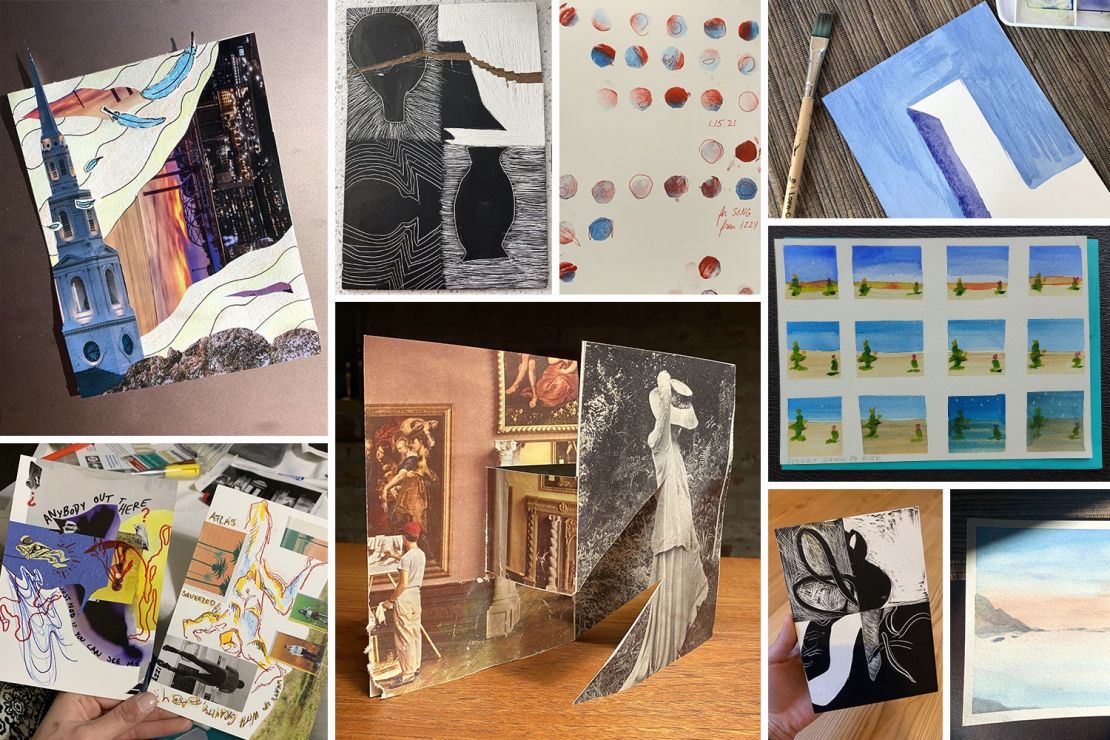During winter quarter, DeAndre Johnson, a first-year student at Stanford, curated his first art exhibit when he arranged an atmospheric watercolor painting, an etching of a water bottle and a pale orange kite on the top of a dresser in his family’s home in Georgia.

A collage of artwork done by students enrolled in Mail Art, a class offered by ITALIC, an academic arts program for first-year students. (Image credit: Andrew Brodhead)
The artists in Johnson’s exhibition were Stanford students enrolled in Mail Art, a class offered by ITALIC, an academic arts program for first-year students. Each week, students made art together, remotely, during workshops offered by seven master artists. They created artwork small enough – 5 by 7 inches – to send across the country by mail.
“What’s most special about the Mail Art exhibit atop my dresser is that each work is unified by the dimensions of a postcard, a reminder of each work’s journey with the U.S. Postal Service,” Johnson said. “It’s a nice daily reminder of the community we’ve built in class. I get really excited – as every kid does – when I see that I have mail.”
Johnson was one of 13 students enrolled in Mail Art. Class organizers sent supplies to the students: stamps, envelopes, papers, watercolor paint sets, colored pencils, a glue stick, embroidery floss, scratchboard, craft foam and ink pads.
Each week, students were paired with different classmates and mailed the artwork they created during the workshop to their partners.
Each of the artists who led workshops provided students with a one-word theme for their session: airmail; flight; light; space; thresholds; unfolding; amend.
Taking flight with collage
Mixed-media painter Stuart V. Robertson, a lecturer in art practice at Stanford who chose “flight” as his theme, told students that their challenge was “to communicate some evidence or impact of flight in a place or space.” Robertson, who earned a Master of Fine Art degree at Stanford in 2020, described his workshop as “a mashup of drawing and collaging.”
He set up a camera to give students an overhead view of his workspace. As he walked them through the steps of creating collages, he talked about his approach to the art form, including concept, composition, materials, layering, orientation and editing.
Song Wu, a sophomore majoring in mechanical engineering in the School of Engineering and in arts practice in the School of Humanities and Sciences, said she especially enjoyed hearing Robertson talk about his creative process.
“Artistic processes can be somewhat mystical at times, so it’s always great to see how the magic is made,” Wu said. “I really enjoyed his thoughts on word association and on learning how to navigate through art and life by choosing the right words.”
During the workshop, students created a layout using images they had selected, following Robertson’s suggestion to paste them provisionally. Then, he asked them to remove half of the images, keeping only the most visually compelling ones, and to lightly sketch possible renditions of the particular kind of flight they were exploring. He encouraged them to add or remove layers as they continued creating their collages.
At the end of the workshop, Robertson showed students a painting he is working on that depicts the dining room of his grandparents’ home in Jamaica, with three figures sitting at a table laden with food. He told them the table was where he spent the majority of time with his grandparents and that the painting was about “home.”
Gray Wong, a senior majoring in symbolic systems, said Robertson’s emphasis on home and family resonated with him.
“My family encouraged me to engage with art in different ways,” he said. “My father, who worked at design and advertising agencies, encouraged me to experiment with his leftover materials. My love for art comes in part from being exposed to art from the time I was a child and I am really thankful for that. I owe how far I’ve come as an artist to my family.”
Sharing artwork collapses distance
Lecturer Kim Beil, who taught the Mail Art class and is the associate director of ITALIC, said making something tangible with one’s own hands provides a sense of deep satisfaction.
“It’s tremendously rewarding to feel as if you’ve brought something new into the world, which is what we do when we make art,” she said.
“After spending hours in Zoom classes, then writing papers in Word and doing research or other work online, it’s enormously satisfying for students to make something physical. These projects don’t disappear from view when you close your laptop.”
Beil, an art historian, said receiving artwork as a gift is a thrill that connecting through social media, emails and phone calls don’t approximate.
“There’s something very special about holding an object in your hands that was made by someone else especially for you,” said Beil, who sent and received art from students enrolled in the class. “The experience collapses distance, both geographic and social.”
To see the artwork students created in Mail Art, visit their online gallery here.
To see examples of Robertson’s artwork, visit the online exhibition “Freeform,” presented by the Stanford Department of Art & Art History, here.